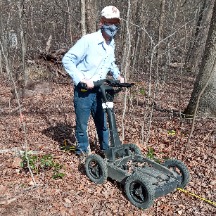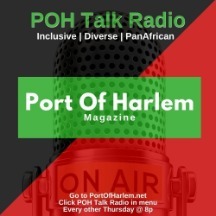Some of those buried in the Mount Nebo African Methodist Episcopal (AME) Church cemetery in Bowie, Maryland, outside of Washington, DC, were probably once enslaved. As freed people, most were small tobacco farmers or sharecroppers.
Though they lived at the bottom of the social/economic ladder, memories of them and their final resting places are being restored. “The work of the church’s members to reclaim the cemetery is proof that to many people Black lives matter in death, too,” says Morgan State University Archivist Dr. Ida Jones.
To preserve the cemetery, restore the church, and offer educational programming, Mount Nebo church members formed the non-profit Friends of Historic Mount Nebo Preservation Corporation (FOHMNPC). They recently hired Dr. Tim Horsley to help them identify unmarked graves that are in the cemetery adjacent to the church.
The archaeological geophysician used a ground-penetrating radar (GPR) machine that uses positive energy to create sub-terrain maps that can identity human burials with near accuracy. One of the sources of false findings, he says, is that burials “often disappear” in about 80 years after the bodies and burial materials have returned to dust.
“We are also collecting transcripts of people who are buried in the graveyard and how what they endured relate to today’s injustices.”
- FOHMNPC Cemetery Project Manager Jan Hagey
The earliest recorded burial was in 1859, more 150 years ago; with many of the bodies facing east, which is a Muslim tradition. Islamic influences are not atypical in African American spirituality says Amir Muhammed of America’s Islamic Heritage Museum and Cultural Center in Washington, DC. On the outside of some of the pews at the historic First African Baptist Church in Savannah, the oldest Black church In North America, are writings done in classical West African Arabic script from the 1800s.
Horsley’s research is part of an extensive plan for the site which once included a two-room schoolhouse that was the hub of Queen Anne’s Black community for more than 100 years. The community was a small one in Prince George’s County, Maryland, with only about 150 residents at its peak. It was also the home of a former seaport on the Patuxent River; most of the town's former waterfront area is now part of Patuxent River Park.
“We are also collecting transcripts of people who are buried in the graveyard and how what they endured relate to today’s injustices,” says FOHMNPC Cemetery Project Manager Jan Hagey, who is originally from Columbus, Ohio and came to the area in the 1980s. Using her education outreach training, she shared the story of Dr. Williams Lang Watkins who moved to the community and sought to live on Queen Ann Bridge Road around 1876.
Hagey says that when White residents told Watkins that no “N” was going to live there, he told them, “I am not a “N” and I will live where I want to live.” She added, “He did move there and his descendants are still in the area.”
By 1965, many Black families had begun moving out of the then rural Mitchellville/Bowie area. Many migrated to the nearest big city, Washington, DC., whose eastern border is seven miles away.
Glenda West’s family was one of those families. “It was country and we lived on Binger Farm where my grandmother used to work as the maid,” she recalls. She remembers walking about two miles from her home to Mount Nebo church and adjacent Mount Nebo (Colored) Elementary School.
The nearest thing to a town was Upper Marlboro, 11 miles away.
It was around 1955, during an era of continued Black urbanization, when West’s family moved from Hall Station, an area many now call Mitchellville/Bowie, to the Washington, DC neighborhood of Fort Dupont, Southeast. Her grandmother moved to Capital Heights, Maryland, just off the DC-Maryland boundary line.
Black Lives Matter in Death, Too – Mt Nebo AME Preserves Historic Cemetery
Praising the Past






Like my grandparents, Maude Jones Savoy Brown and William Savoy, “I still go to Mount Nebo,” which is about seven miles from where I live in Fort Dupont, DC, she says. Her grandfather is buried in the historic cemetery.
“I think (the preservation) gives you a sense of pride to acquaint yourself with the Black people living before you were even born.”
- FOHMNPC President Glenda West and former Mount Nebo Colored Elementary School student.
Shedding its racist past, Prince George’s experienced the return of some Blacks it had lost and an influx of "new" Blacks in the early 1980s, such as Hagey and FOHMNPC Building Project Manager Michael Gaddy. The county is now largely suburban and majority Black and, ironically, Mitchellville now has one of the highest majority African income neighborhoods in the United States.
Though he is a Philadelphia native, Gaddy has been eager to lend his skills to preserve the history of the community West’s family has populated for generations. He says, “My experience in the government as a grant auditor provided me the tools to administer the grant to restore the building, but I rely on other people with expertise when it comes to the restoration of the actual structure.”
Formerly enslaved Africans founded Mount Nebo AME Church June 8, 1877. A log cabin on an acre of land purchased for $134.55 (more than $3,300 in current dollars) served as the original church and built adjacent to Mount Nebo (Colored) Elementary School, which was built in 1875 and that West attended as a child.
The current and second church building on the historic site was built in 1925 with no running water, electricity, or indoor bathroom facilities. A “pot belly” stove provided heat. One of the church activities included an annual pilgrimage to the Chesapeake Bay Beach for old fashion Baptismal services.
The fourth building to serve the church was completed in 2010 and the congregation renamed the church, Greater Mount Nebo African Methodist Episcopal Church. The deed for the 1925 site remains in the hands of the current congregation.
Funding for the preservation is provided in part by Preservation Maryland and the Maryland Historical Trust. West, who is now bombarded by real estate salespeople calling to ask if she wants to sell her parent’s home in gentrifying Washington, DC, added, “I think (the preservation) gives you a sense of pride to acquaint yourself with the Black living people before you were even born.”
Listen and join in a conversation about historic Mount Nebo with POH publisher Wayne Young, Morgan State University Archivist Dr. Ida Jones, and Friends of Historic Mount Nebo Preservation Corporation Glenda West, Jan Hagey, and Michael Gaddy, Thursday, April 1, 8p-9p on Port Of Harlem Talk Radio.
Prosperous White Farmer Claims Self-Defense for Killing Negro Named Thomas Turner
When Society Discovered that Dr. Watkins was a Negro
Dr. Watkins, The Colored Who Defied Housing Segregation Circa 1880
The Flu Shuns Us, Says Health Doctor
How Maryland Colored Schools Finally Got Free Books
“I think (the preservation) gives you a sense of pride to acquaint yourself with the Black people living before you were even born.”
- FOHMNPC President Glenda West and former Mount Nebo Colored Elementary School student.
Shedding its racist past, Prince George’s experienced the return of some Blacks it had lost and an influx of "new" Blacks in the early 1980s, such as Hagey and FOHMNPC Building Project Manager Michael Gaddy. The county is now largely suburban and majority Black and, ironically, Mitchellville now has one of the highest majority African income neighborhoods in the United States.
Though he is a Philadelphia native, Gaddy has been eager to lend his skills to preserve the history of the community West’s family has populated for generations. He says, “My experience in the government as a grant auditor provided me the tools to administer the grant to restore the building, but I rely on other people with expertise when it comes to the restoration of the actual structure.”
Formerly enslaved Africans founded Mount Nebo AME Church June 8, 1877. A log cabin on an acre of land purchased for $134.55 (more than $3,300 in current dollars) served as the original church and built adjacent to Mount Nebo (Colored) Elementary School, which was built in 1875 and that West attended as a child.
The current and second church building on the historic site was built in 1925 with no running water, electricity, or indoor bathroom facilities. A “pot belly” stove provided heat. One of the church activities included an annual pilgrimage to the Chesapeake Bay Beach for old fashion Baptismal services.
The fourth building to serve the church was completed in 2010 and the congregation renamed the church, Greater Mount Nebo African Methodist Episcopal Church. The deed for the 1925 site remains in the hands of the current congregation.
Funding for the preservation is provided in part by Preservation Maryland and the Maryland Historical Trust. West, who is now bombarded by real estate salespeople calling to ask if she wants to sell her parent’s home in gentrifying Washington, DC, added, “I think (the preservation) gives you a sense of pride to acquaint yourself with the Black living people before you were even born.”
Listen and join in a conversation about historic Mount Nebo with POH publisher Wayne Young, Morgan State University Archivist Dr. Ida Jones, and Friends of Historic Mount Nebo Preservation Corporation Glenda West, Jan Hagey, and Michael Gaddy, Thursday, April 1, 8p-9p on Port Of Harlem Talk Radio.
Tales from Historic Mount Nebo Series
Is an ongoing series of stories about people connected to the historic Mount Nebo African American Episcopal Church, Cemetery, and/or Colored School in Bowie, Maryland. Subsequent articles in this Series:Prosperous White Farmer Claims Self-Defense for Killing Negro Named Thomas Turner
When Society Discovered that Dr. Watkins was a Negro
Dr. Watkins, The Colored Who Defied Housing Segregation Circa 1880
The Flu Shuns Us, Says Health Doctor
How Maryland Colored Schools Finally Got Free Books
Advertisers | Contact Us | Events | Links | Media Kit | Our Company | Payments Pier
Press Room | Print Cover Stories Archives | Electronic Issues and Talk Radio Archives | Writer's Guidelines






